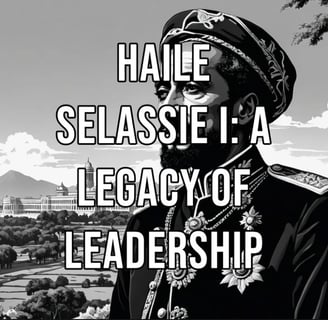From Monarch to Martyr: Haile Selassie's Journey
Ever wondered how a monarch could symbolize both a nation's hope and its complex challenges? Join us as we unravel the extraordinary life of Haile Selassie I, Ethiopia's last emperor, who stood at the crossroads of tradition and modernity. Discover his unique upbringing that mixed noble heritage with Western influences, which fueled his ambitious vision to reform Ethiopia's legal framework, education system, and infrastructure. Despite facing resistance, his political acumen led to groundbreaking changes, including the 1931 Constitution that sought to balance power. Yet, just as his reforms began to take shape, the looming threat of Mussolini's invasion cast a shadow over his reign.
Footprints In The Dark
10/13/20242 min read


Haile Selassie I, the last emperor of Ethiopia, remains an enigmatic figure whose influence transcends borders and cultures. His reign, marked by both triumphs and tribulations, stands as a testament to the complex nature of leadership in a rapidly changing world. As Ethiopia's last emperor, Haile Selassie embodied a unique blend of tradition and modernity, navigating the challenges of governance with a vision for progress that still resonates today. His life and legacy offer a fascinating lens through which we can explore the intricate dynamics of resistance, reform, and cultural impact.
Born to Fari Mokonnen, Haile Selassie's early life was characterized by a blend of noble heritage and exposure to Western influences. This diverse upbringing shaped his worldview, fueling his ambition to reform Ethiopia's legal, educational, and infrastructural systems. Upon ascending to the throne in 1930, Selassie embarked on a series of ambitious reforms aimed at modernizing the nation. These efforts were not without resistance, as entrenched nobility and conservative factions pushed back against change. Nonetheless, his political acumen enabled him to enact the 1931 Constitution, a groundbreaking document that sought to create a constitutional monarchy by limiting elite power.
Selassie's reign was soon overshadowed by the threat of Mussolini's invasion, which cast a dark shadow over his efforts to modernize Ethiopia. The Italian invasion in the 1930s was a pivotal moment, highlighting the limitations of the League of Nations and Selassie's desperate plea for international support. His defiant stand against fascism turned him into a global symbol of resistance, and despite the League's shortcomings, Selassie's unwavering determination inspired many around the world. This chapter in his life not only exposed the flaws of international diplomacy but also foreshadowed the global conflict that would soon erupt with World War II.
After the war, Selassie returned to power, determined to rebuild Ethiopia and redefine its place on the world stage. He recognized the importance of international presence, leading Ethiopia to join the United Nations in 1945. Selassie emerged as a vocal advocate for African decolonization, using platforms like the UN to champion liberation movements across the continent. His efforts culminated in the establishment of the Organization of African Unity in 1963, solidifying his legacy as a visionary leader who believed in a united and free Africa.
Despite these achievements, Selassie's leadership was not without internal challenges. Ethiopia faced significant economic disparities, and the devastating famine of 1973 highlighted the limitations of his government. These issues fueled dissent and unrest, ultimately leading to the rise of the Derg regime. In 1974, Selassie was deposed in a bloodless coup, marking the end of his reign and the beginning of a dark chapter in Ethiopia's history. The circumstances surrounding his mysterious death remain a subject of debate, adding another layer of complexity to his legacy.
Interestingly, while Selassie's impact on Ethiopia was profound, his influence extended far beyond its borders. His image became central to the Rastafari movement, a religious and cultural movement that emerged in Jamaica in the 1930s. The Rastafarians saw Selassie as a messianic figure, a symbol of black empowerment and liberation. Despite being a devout Ethiopian Orthodox Christian, Selassie's connection with the movement was acknowledged through meetings with Rastafarian leaders, illustrating the unexpected and far-reaching impact of his legacy.
Throughout his life, Haile Selassie was a champion for progress and modernization, yet his leadership was marked by contradictions and challenges. As we reflect on his legacy, we are reminded that history is rarely black and white. Selassie's story is a tapestry of triumphs and tragedies, progress and setbacks, that invites us to examine the complexities of leadership and the enduring influence of iconic figures.
